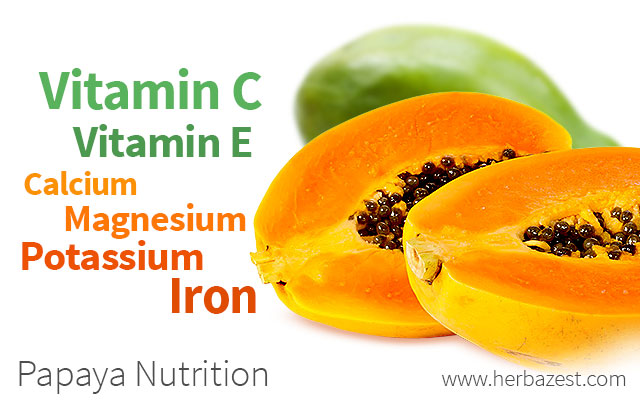Responsible for triggering powerful anti-inflammatory, antioxidant, and antimicrobial effects in the body, the nutrients in the papaya fruit papaya have directly influenced many traditional folk uses and scientifically-backed health benefits.
Papaya's Essential Nutrients
Papaya nutrition compress vitamins, minerals, and other vital compounds. Papaya fiber content is high, but the fruit is low in fat, which promotes healthy digestion and lowers glucose levels. Accounting for nearly 7 - 10% of the daily recommended intake, the fiber content in papaya also fosters satiety, helping to curb cravings for effective weight management.
Papaya vitamins, mainly C (ascorbic acid) and E (tocopherols), work together to prevent heart disease and other illnesses caused by free radical damage.
VITAMINS C AND E IN PAPAYA PLAY AN ACTIVE ROLE IN CELLULAR REPAIR, COLLAGEN PRODUCTION, AND WOUND HEALING, AND ARE HIGHLY REGARDED FOR THEIR PROTECTIVE, ANTI-AGING EFFECTS ON THE SKIN.
In addition, papaya calories per serving are not significant, amounting for a total of 43 kcal per 100 grams. With approximately 0.47 g of protein, 10.82 g of carbohydrates, and 7.82 g of sugar, papaya boosts energy production, and along with its content of minerals - such as calcium, iron, magnesium, phosphorus, and potassium - helps the body to carry out important biological functions.
Papaya's Supporting Compounds
Primarily extracted from the sun-dried latex of the unripe, green papaya, papain is a digestive enzyme that helps break down proteins, lowers inflammation, and has exhibited antioxidant effects. Papain is actually the most important and chemically-potent compound influencing papaya medicinal uses. It is often consumed or topically applied to soothe painful gastrointestinal upsets and heal skin problems caused by cuts, burns, and other forms of trauma.
Additionally, papaya contains carotenoids, powerful orange phytopigments that protect skin cells from harmful UV rays and give the papaya fruit its bright orange color. Beta-carotene and lycopene seem to be the most significant, protecting against naturally-occurring oxidative stress in the body.
Although there is some evidence suggesting a much lower content of carotenoids in papaya than tomato and carrot, a randomized study from the British Journal of Nutrition (2014) found that these compounds are almost three times more likely to be used by the body when derived from papaya. Furthermore, considering that the body converts carotenoids into usable vitamin A, this would suggest the superior efficacy and nutritional value of papaya in the reversal of vitamin A deficiency.
Though their mechanisms are not as widely studied in papaya, carpaine and fibrin support optimal cardiovascular health by lowering blood pressure and improving the function of blood cells.
Papaya Nutrition Facts
The following papaya nutrition facts help to further illuminate its usefulness in alternative healthcare and manufacturing:
Most of the calories in papaya come from complex carbohydrates and allow for a steady supply of glucose, making this fruit a great choice for blood sugar management.
The developmental stage can drastically affect the nutritional value of papaya. Whereas carotene, sucrose, and fat all increase significantly as the papaya matures, its fiber content and vitamin C decrease as it ripens.
100 grams of ripe papaya contain 182 mg of potassium, a very important mineral for the proper function of all cells, tissue, and internal organs.
One small, ripe papaya contains up to 75% of the daily recommended intake of vitamin C.
- Papain is more abundant in immature, green papaya fruits, and it is used to clarify beers, tenderize meat, and as an additive in chewing gum.
Today, the nutrients in papaya can be found in dietary supplements and natural products intended to deliver its healing properties in safe doses. As many of its traditional uses in herbal therapy have been validated by science, papaya has become a shining star of nutrition.
Sources
- Academy of Nutrition and Dietetics, What is Fiber
- African Journal of Agricultural Research, Drug bioavailability and traditional medicaments of commercially available papaya: A review, 2013
- International Journal of Pure and Applied Sciences and Technology, Comparative study on the nutritional content of Carica papaya at different ripening stages, 2013
- Journal of Medicinal Plants Studies, Traditional and medical uses of Carica papaya, 2013
- Journal of Pharmacy and Biological Sciences, Evaluation of nutritional components of Carica papaya L. at different stages of ripening, 2013
- National Institutes of Health, Vitamin C | Vitamin E | Vitamin A
- The British Journal of Nutrition, Carotenoids are more bioavailable from papaya than from tomato and carrot in humans: a randomized cross-over study, 2014
- University of Hawaii, Papaya | The Hawaii Papaya Industry Association, Nutrition Facts
- USDA Nutrient Database, Papayas, raw
- American Journal of Clinical Nutrition, Interaction among vitamin C, vitamin E, and beta-carotene, 1995




